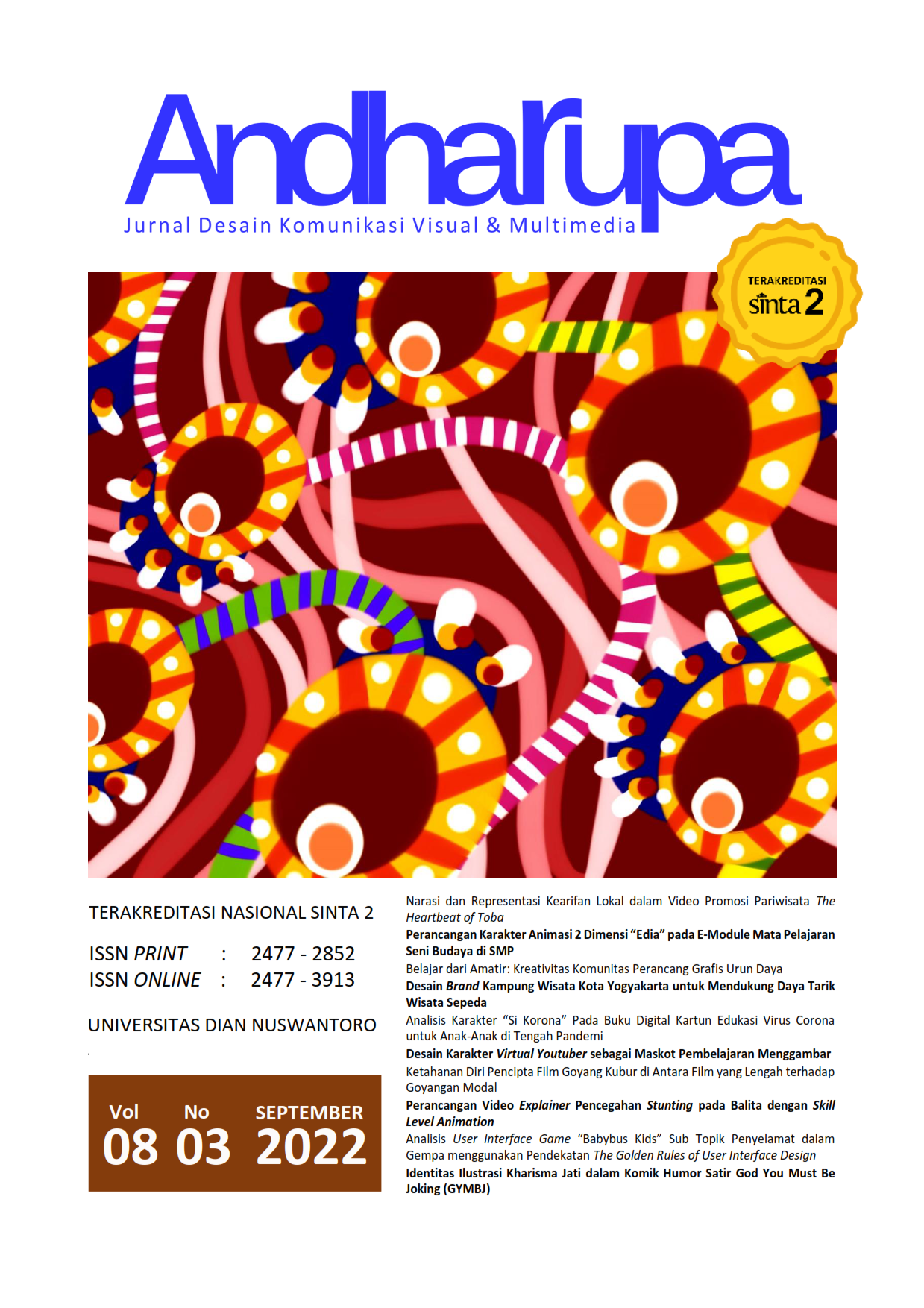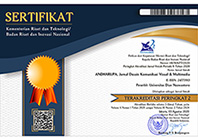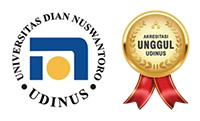Belajar dari Amatir: Kreativitas Komunitas Perancang Grafis Urun Daya
DOI:
https://doi.org/10.33633/andharupa.v8i3.6933Abstract
Abstrak Urun daya rancang grafis merupakan fenomena yang menarik untuk diteliti mengingat Indonesia adalah salah satu penyumbang sumber daya urun daya terbesar di dunia. Walaupun mendapat penolakan dari asosiasi dan para profesional, eksistensi para perancang grafis urun daya tetap berdaya. Penelitian ini bertujuan untuk mengetahui pengalaman para perancang dalam mengembangkan kemampuan kreatif dan sikap perancangan sehingga mampu bertahan dan diterima oleh klien. Penelitian ini akan berguna bagi peneliti dan dunia akademis yang selama ini lebih banyak mengadopsi prinsip, metode, dan etika perancangan modern yang mapan. Pengalaman komunitas akan menyumbang keberagaman dalam praktik perancangan. Penelitian ini menggunakan metode fenomenologi yang mengandalkan data hasil wawancara dan pengamatan. Langkah penelitian dimulai dengan investigasi pengalaman pribadi, dilanjutkan penelusuran sumber etimologis dan pergeseran makna untuk memperoleh deskripsi pengalaman perancang. Metode penelitian ini bertujuan menyarikan pengalaman kreatif para perancang menjadi pemahaman tentang sifat khas dari pengalaman tersebut. Hasil yang didapatkan adalah deskripsi pengalaman perancang dari proses kreatif sejak fase meniru, modifikasi, konseptualisasi, hingga transformasi. Pengalaman belajar dan bekerja membentuk perancang yang akomodatif terhadap segala perubahan dan toleran terhadap klien. Penelitian menyimpulkan adanya nilai strategis dari penghargaan perancang terhadap keberadaan klien, produk, dan lingkungannya. Hal ini juga ditandai dengan perkembangan praktik kreatif. Proses perancangan tidak lagi mengandalkan logika perancang semata. Kata Kunci: fenomenologi, kreativitas, rancang grafis, transformatif, urun daya AbstractGraphic design crowdsourcing was an interesting phenomenon to be researched, considering that Indonesia is one of the most crowdsourcing contributors resources in the world. Despite being rejected by associations and professionals, the existence of crowdsourcing graphic designers remained significant. This study aimed to determine the experience of designers in developing creative abilities and design attitudes so that they could survive and be accepted by clients. This research will be helpful for researchers and academics who have been adopting more established principles, methods, and ethics of modern design. Community experience will contribute to diversity in design practice. We used phenomenological methods that relied on data from interviews and observations. The research step begins with an investigation of personal experience, followed by a search for etymological sources and shifts in meaning to obtain a description of the designer's experience. This method aims to extract the creative experience of designers into an understanding of the distinctive nature of those experiences. The results describe the designer's experience in the creative process from the imitation, modification, conceptualization, and transformation phases. The research concludes a strategic value in the designer's respect for the existence of the client, the product, and the environment. The design process no longer relies on the designer's logic alone. Keywords: creativity, crowdsourcing, graphic design, phenomenology, transformativeReferences
ADGI, ADPII, AIDIA, HDII, HDMI, & IFC. (2020). Dasar Pengadaan & Pengelolaan Jasa Desain di Indonesia Buku 1. Kementerian Pariwisata dan Ekonomi Kreatif Deputi Bidang Kebijakan Strategis.
ADPII, ADGI, AIDIA, HDII, HDMI, & IFC. (2021). Riset Standar Harga Jasa Desain di Indonesia. Direktorat Kajian Strategis Deputi Bidang Kebijakan Strategis Kementerian Pariwisata dan Ekonomi Kreatif/Badan Pariwisata dan Ekonomi Kreatif.
AIGA. (2009). AIGA Position on Spec Work. https://www.aiga.org/resources/aiga-position-on-spec-work
Airey, D. (2010). Spec work: bad for client, bad for designer. https://www.davidairey.com/spec-work-in-graphic-design
Boden, M. A. (2004). The Creative Mind: Myths and Mechanisms. Routledge.
Bossel, V., Geyskens, K., & Goukens, C. (2018). Facing a Trend of Brand Logo Simplicity: The Impact of Brand Logo Design on Consumption. Food Quality and Preference, 71.
Brabham, D. C. (2013). Crowdsourcing. The MIT Press.
Cabral, T. (2019). Creativity and a Social Graphic Design Project in the Rego Neighbourhood in Lisbon. Advances in Intelligent Systems and Computing, 825, 717–726.
Dong, Y. (2021). Promoting sustainable creativity: An empirical study on the application of mind mapping tools in graphic design education. Sustainability (Switzerland), 13(10).
Femia, J. V. (2006). Pareto and Political Theory. Routledge.
Fischer, G., & Giaccardi, E. (2007). Sustaining social creativity. Communications of the ACM, 50(12), 28–29.
Guilford, J. P. (1987). Creative research: Past, present, and future. In S. G. Isaksen (Ed.), Frontiers of Creativity Research (hal. 33–65). Bearly Ltd.
Hammon, L., & Hippner, H. (2012). Crowdsourcing. WIRTSCHAFTSINFORMATIK, 54(3), 165–168.
Hashimi, S. Al. (2019). The effectiveness of social media and multimedia-based pedagogy in enhancing creativity among art, design, and digital media students. International Journal of Emerging Technologies in Learning, 14(21), 176–190.
Howe, J. (2006). The rise of crowdsourcing. Wired, 14(6).
Howe, J. (2009). Crowdsourcing: How the Power of the Crowd Is Driving the Future of Business. Random House Business.
Jeffries, K. K. (2018). Design creativity, technical execution and aesthetic appeal: A cat with caveats (Part 2). International Journal of Design Creativity and Innovation, 6(1), 66–79.
Massanari, A. (2012). DIY Design: How crowdsourcing sites are challenging traditional graphic design practice. First Monday, 17(10), 1–14.
Pfiffner, P. (2009). Spec Work and Crowdsourcing: Gambles that Don’t Pay Off. https://creativepro.com/spec-work-and-crowdsourcing-gambles-dont-pay
Ramadhani, S. (2018). Improving creativity of graphic design for deaf students using contextual teaching learning method (CTL). ACM International Conference Proceeding Series, 136–140.
Rina, R. C. (2016). Kaliabu dan Salaman, Ketika Internet Telah Menjamahmu: Cerita Tentang Desainer Kampung di Indonesia. PORTAL Journal of Multidisciplinary International Studies, 13(2), 1–5.
van Manen, M. (1984). Practicing phenomenological writing. Phenomenology+ Pedagogy, 36–69.
Wee, W. (2013). There’s raw talent in Indonesia and Philippines. https://www.techinasia.com/99designs-raw-talent-indonesia-philippines
Young, J. W. (2003). A Technique for Producing Ideas. McGraw-Hill Education.
Yulfa, A. (2012). Crowdsourcing sebagai Upaya Melibatkan Peran Masyarakat dalam Proses Perencanaan Wilayah. Jurnal Skala, 2(4), 13–23.
Downloads
Published
Issue
Section
License
Authors who publish with this journal agree to the following terms:
- Authors retain copyright and grant the journal right of first publication with the work simultaneously licensed under a Creative Commons Attribution License that allows others to share the work with an acknowledgment of the work's authorship and initial publication in this journal.
- Authors are able to enter into separate, additional contractual arrangements for the non-exclusive distribution of the journal's published version of the work (e.g., post it to an institutional repository or publish it in a book), with an acknowledgment of its initial publication in this journal.
- Authors are permitted and encouraged to post their work online (e.g., in institutional repositories or on their website) prior to and during the submission process, as it can lead to productive exchanges, as well as earlier and greater citation of published work (See The Effect of Open Access).















